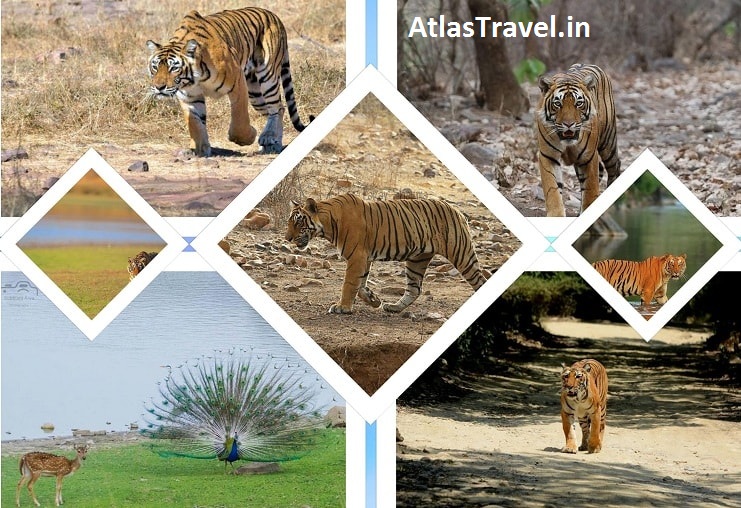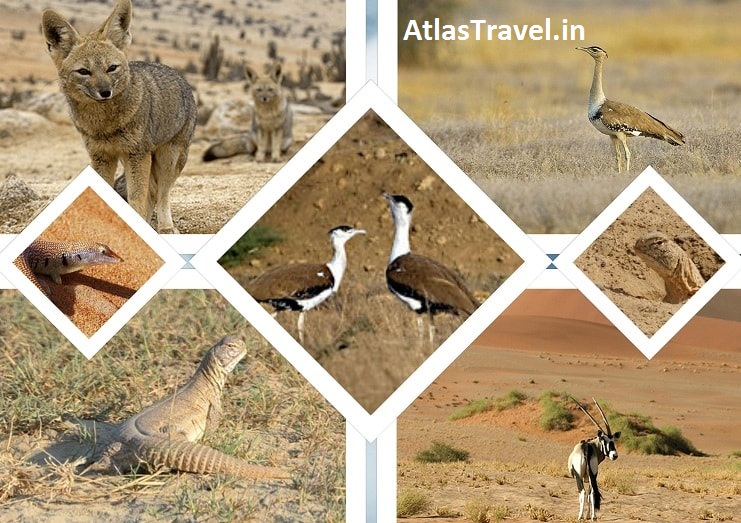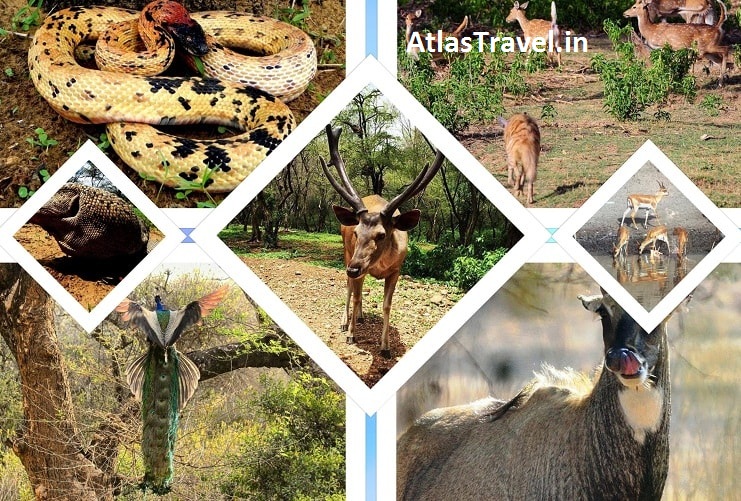Rajasthan represents the colorful mosaic of various age-old cultures and traditions that makes up the subcontinent. Popularly known as the land of palaces and kings, Rajasthan’s unique, one of a kind landscape, ancient cultural heritage and rich, eclectic biodiversity sets it apart from the rest making it one of the prime exotic travel destination for vacationers. Apart from breathtaking palaces, the state of Rajasthan is also a premium stop for thrill seekers and adventure lovers who can spend their time in numerous national parks which are either dedicated to bird watching or tiger reserves.
If you are planning to avail Rajasthan Tour Packages then these are some of the national parks which cannot be missed out on.
List of 04 Wildlife Sanctuaries in Rajasthan
01. Ranthambore National Park, Sawai Madhopur

Ranthambore National Park is located in the state of Rajasthan; India is a fantastic mixture of dense forest and glorious ruins. This park is well known for its vast collection of majestic tigers. Inside this park tigers can be easily spotted. Ranthambore is a place where history and forest meets together. Dotted with all brilliance of nature, this park was once the much favorite hunting preserve of the royal family of Jaipur.
At Ranthambore, one can find opportunity to see tigers seeking shelter under some architectural vividness on hot summer days. One can see a leopard standing majestically on the walls of some old fort.
Located in the Sawai Madhopur district of Rajasthan, India, Ranthambore National Park pans over a massive area of approximately 390 square kilometers of total forest cover.
The Ranthambore National Park is bound by river Banas in the North and river Chambal in the South. Almost certainly this national park is one of the finest and most unique of its kind that is included under Project Tiger. Inside the Ranthambore National Park there are six manmade lakes which are the central focus of the park.
Perennial streams criss-cross and adorn the entire national park enhance the charm of this park. There are around 400 species of trees found in this park. Dhok is the most common trees of this park. In the park there are also some ancient Banyan trees (known to be eight hundred years old) are also the major attraction among the flora and fauna of this park.
Ranthambore National Park is spread in an area of around 400 sq km and here one can see tigers relatively easier than of any other National Parks of India. The best place inside the park to enjoy the wildlife is place near the lakeside.
Lakeside area is also a favorite spot to spot the tigers. Some other wildlife attractions of Ranthambore are Leopards, Jackals, highly endangered Caracal, Jungle Cats, sloth Bear, Wild Boar, Langurs, marsh Crocodile, spotted Deer, Sambhars, and Nilgai etc. Here also can be seen a variety of water and woodland birds.
Located in the district of Sawai Madhopur in the princely state of Rajasthan, India, Ranthambore National Park is easily accessible. It is just 145 km away from the nearest Airport of Jaipur, Rajasthan, India. The best time to visit Ranthambore National Park is the period of November to April because most of the animals can be seen during this period.
2. Desert National Park, Jaisalmer

Situated in near the Golden City of Jaisalmer in the state of Rajasthan, India, Desert National Park is listed among one of the largest national parks in the world. The park covers an area of around 3162 square kilometers. The vast track of Thar Desert around the Golden City of Jaisalmer, Rajasthan, India, with its wood fossils, is known as the Desert National Park.
The Desert National Park is an excellent and one of the finest examples of the ecosystem which is held by the thriving Thar Desert and its rich & diverse fauna. The park has the unique varieties of wildlife species.
The vast track of Thar Desert sands around the Golden City of Jaisalmer with their wood fossils, have been designated as the Desert National Park. Desert National Park is the excellent and finest example of the ecosystem of the vast Thar Desert and its diverse fauna which has the unique varieties of wildlife species.
Around 20 percent of this park is formed with Sand Dunes. The major landform of the Desert National Parks is occupied with the craggy rocks and compact salt lake bottoms, intermedial areas and fixed dunes. There are three main lakes in this Desert National Park – Malik Talao Lake, Padam Talao Lake and Rajbagh Lake. These lakes function as some of the major watering holes for the inhabitants of Desert National park.
There is an abundance of birdlife in the Desert National Park even with its flimsy ecosystem. One can see here endangered Great Indian Bustard (a magnificent bird) in relatively fair numbers.
The region of Desert National Park is asylum for migratory and resident birds of the desert. Some birds which are commonly seen in this region are sand grouse, partridges, bee-eaters, larks and shrikes. In winter one can also see Demoiselle crane and Houbara.
Eagles, Falcons, Vultures, Tawny Eagles, Spotted Eagles, long-legged & honey buzzards and Kestrels can be also seen here. Generally, Sand Grouse are seen near small ponds or lakes. The wholesome wildlife collection of the Desert National Park includes numerous animals like Blackbuck, Chinkara, Desert fox, Bengal Fox, Indian Wolf, Desert Cat, Hare, etc.
Jaisalmer is well-connected by rail or road from all the major cities of India. Nearest airport is Jodhpur which is 295 km away. The best time to visit the Desert National Park is October to March.
3. Keoladeo National Park, Bharatpur

Situate at the distance of 176 km from Delhi in Bharatpur in the state of Rajasthan, India is a very special wilderness – Keoladeo Ghana National Park can also be mentioned as Bharatpur Bird Sanctuary or Ghana Pakshi. Keoladeo Ghana National Park is one of the finest water bird sanctuaries in the world.
This park is heaven for birds. Inside the Keoladeo Ghana National Park there are verities of bird species from across the world. This park is stretched in the area of 29 sq km, around ten square km of which is marshes and bogs. Rest of the area of this park occupies of grasslands and around 44,000 trees which are used for shelter for birds all through the year. There are approximately 380 species of birds in this park. Previously this park was the duck shooting preserve for the Maharaja Suraj Mal of Bharatpur.
Keoladeo Ghana National Park is declared as the World Heritage Site by UNESCO in 1985. The park is well-known as the most important breeding and feed grounds for the birds in the world. Major wildlife attractions of Keoladeo Ghana National Park are numerous migratory birds (come from as far away as Central Asia & Siberia to spend their winter in the Bharatpur National Park).
Migratory birds as Bharatpur Bird Sanctuary are several species of Cranes, Pelicans, Geese, Ducks, Eagles, Hawks, Shanks, Stints, Wagtails, Warblers, Wheatears, Flycatchers, Buntings, Larks and Pipits, etc. In fact this park is heaven for all types of birds. The park remains open for visitors throughout the year. Some of the best months to visit are August-November when the resident breeding birds come back to the park and during the months of November-March to witness migrant birds.
Commonly called as Bharatpur Bird Sanctuary, this park is a delight for bird viewers. Over 350 species of birds are found in this park. One can enjoy boat ride in the early hours of morning which is surely an unforgettable experience.
One can also enjoy cycle-rickshaw ride in the park to view the birds and other wildlife attractions, such as; Sambhar, Chital, Nilgai, Fox, Hyena, Jackal, Sambhar, Porcupine and Mongoose. This park is the best place to watch the Siberian Crane. Occasionally, a fishing cat can be seen digging its prey from water-edge.
Pythons are also seen sunning themselves alongside the edge of the paths or at Python Point.
Bharatpur is well-connected by road from all the major cities of India. Bharatpur can be arrived easily. Accommodation in Bharatpur is also good. Best time to visit Bharatpur Bird Sanctuary is the period of November to March.
4. Sariska National Park, Alwar

Sariska National Park is most certainly one of the most visited and one of the most popular national parks in the subcontinent. Sariska National Park is well-nestled in the Aravalli hills and close to Delhi, the capital of India. One can see the tigers in natural surrounding at Sariska National Park. Sariska was once the hunting preserve of Maharajas of Alwar.
Sariska covers an area of 800 sq km in total with a core area of around 500 sq km. The area of Sariska was declared as a wildlife sanctuary in 1955 and became a national park in 1979. Sariska Tiger Reserve is situated among the Aravalli Hill ranges in the district of Alwar in Rajasthan, India.
Sariska National Park is larger than Ranthambore National Park and less commercialized than Ranthambore. It has less tigers than Ranthambore has but the park has similar topography as the Ranthambore National Park. The Sariska National Park has many monuments of religious significance situated within the boundaries of the Park. This park remains open for visitation throughout the year.
Sariska National Park is the best place to enjoy camel safaris, elephant safaris, shopping in the surrounding places of the park and watching wildlife attractions. A large part of this sanctuary is covered with the Dhok Trees. The park accommodates various wildlife species. Some major wildlife attractions of Sariska National Park are tigers, leopards, chital, Sambhar, nilgai, wild boar, hyena, jungle cats, four horned antelope and langur. The best time to visit Sariska National Park is between the months of November and June. Summer months offer a better view of the wildlife attractions of Sariska but the climate remains extremely hot.
Where to Stay
The best place to stay at Sariska is Sariska Palace. Built in the 19th century this impressive palace was a hunting lodge for the Maharajas. Now the Sariska Palace is turned into a heritage hotel with all modern facilities, such as; huge lawns to relax and beautiful swimming pool. Sariska Palace Hotel is built in a total area of 50 acres.
How to get at Sariska
With the nearby towns Sariska is well-connected. The closest main town to Sariska is the vibrant city of Alwar, situated at the distance of 36 km. To arrive at Sariska, nearest Railway Station is at Alwar and nearest Airport is at Jaipur. Sariska National Park is also very easily accessible from Delhi.
Suggested Tours
- Rajasthan tour packages from Pune
- Rajasthan tour packages from Mumbai
- Rajasthan tour packages from Kolkata
- Rajasthan tour packages from Ahmedabad
- Rajasthan tour packages from Delhi
- Rajasthan tour packages from Bangalore
- Rajasthan tour packages from Vadodara
- Rajasthan tour packages from Chennai
- Rajasthan tour packages from Hyderabad
- Rajasthan tour packages from Surat

 Call
Call WhatsApp
WhatsApp Enquiry
Enquiry